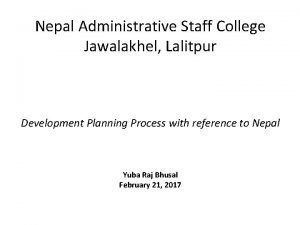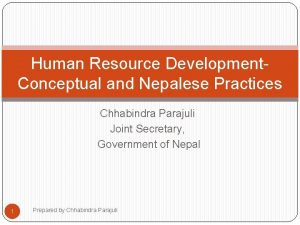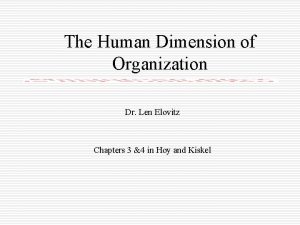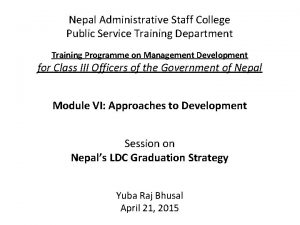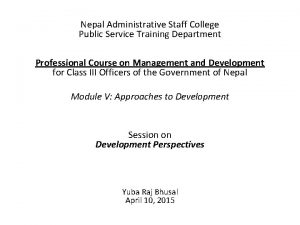Nepal Administrative Staff College Governance and Development Management






















- Slides: 22

Nepal Administrative Staff College Governance and Development Management Learning Group Center for Governance and State Management Professional Course on Governance and State Management for Class II Officers of GON Module II: Governance Session on: Public Accountability Yuba Raj Bhusal Senior Director, NASC August 20, 2015

Presentation Outline 1. Background 2. The Concept 3. Types 4. Dimensions 5. Nepalese Context 6. Challenges and Opportunities

1. The State and its Organs ç Legislature Media THE STATE GOD Generator Operator Destroyer to Evil-doers c a|xd p lji 0 f' d dx]Zj/ Executive The State Judiciary Generator= Legislature Operator = Executive Destroyer = Judiciary

2. The Concept 2. 1 Public • Publics are groups of individuals, and the public is the totality of such groupings. • It means a population of individuals in association with civic affairs, or affairs of office or the state. • It has notions of audience, market segment, community, constituency, and the stakeholders.

Types of Public: • Target publics’ involvement is necessary for achieving organizational goals; • Intervening publics form opinions and mediate, who also pass information to the target publics; and • Influential publics are the publics that the target publics turn to for consultation and services.

2. 2 Accountability • The concept of account-giving has ancient roots in record keeping activities related to governance and money-lending systems that was first developed in ancient Israel, Babylon, Egypt, Greece and later in Rome. • It is related to ethics and governance with several meanings such as answerability, blameworthiness, liability, and account-giving. • As an aspect of (good) governance, it is related to problems in the public, non-profit and private (corporate) worlds as well. • Accountability may be moral, administrative, political, managerial, market, legal/judicial, constituency relation, professional etc.

2. 3 Public Accountability • In public sector leadership, accountability is the acknowledgment and assumption of responsibility for actions, products, decisions, and policies including the administration, governance, and implementation within the scope of the role or employment position and encompassing the obligation to report, explain and be answerable for the consequences. • It involves the obligations of public enterprises and agencies who have been entrusted with public resources to be answerable for fiscal and social responsibilities, to those who have assigned such responsibilities to them.

• Accountability = f(answerability + responsibility). • According to Mark Bovens, public accountability is the hallmark of modern democratic governance. It is one of the ingredients of good governance. • As an institution, it is the complement of public management. Now, public relates to “openness”, or the account giving is done in public, i. e. , it is open or at least accessible to citizens. • Public means the public sector and thus focus is made on public managers, on officials spending public money, exercising public authority, or managing a corporate body under public law. • It covers all the three organs of the state.

3. Types Public institutions are frequently required to account for their conduct to various forums in a variety of ways. Mark Boven has categorized it as under (The Oxford Handbook of Public Management, Oxford: Oxford University Press 2005): 4. 1 Based on the nature of the forum • Political accountability • Legal accountability • Administrative accountability • Professional accountability • Social accountability 4. 2 Based on the nature of the actor • Corporate accountability • Hierarchical accountability • Collective accountability • Individual accountability

3. Types contd. . 4. 3 Based on the nature of the conduct • Financial accountability • Procedural accountability • Product accountability 4. 4 Based on the nature of the obligation • Vertical accountability • Diagonal (crosswise) accountability • Horizontal accountability

Horizontal accountability

Vertical accountability

4. Dimensions of Public Accountability: 4. 1 An icon/image: an instrument and a goal, 4. 2 An institutional arrangement: An occasional, self-instituted evaluation of an independent agency does not constitute an accountability arrangement. It is institutionalized. 4. 3 It involves social relations: a relationship between an actor and a forum, in which the actor has an obligation to explain and to justify his/her conduct, the forum can pose questions and pass judgment, and the actor can be sanctioned.

4. Dimensions contd… 4. 4 The problem of many eyes (the actor-forum relationship). There at least five forums to respond: • Political accountability: elected officials, political parties, voters, media; • Legal accountability: courts; • Administrative: auditors, inspectors, controllers; • Professional accountability: professional peers; • Social accountability: interest groups, charities and other stakeholders.

4. Dimensions contd… 4. 5 The problem of many hands: • Corporate accountability: the organisation as an actor ; • Hierarchical accountability: One for all (Ministers, CEO); • Collective accountability: All for one (in the case of organisational misconduct, every member of the organisation can be held accountable); • Individual accountability: Each for him/herself.

4. Dimensions contd… 4. 6 Aspects of Accountability: • financial, procedural, products etc; • vertical, diagonal and horizontal accountability; 4. 7 Assessing accountability • Proper provision of information; • Proper debate; • Proper judgment procedure. 4. 8 Evaluating the external effects of accountability: • The democratic perspective: popular sovereignty; • The constitutional perspective: prevention of corruption and abuse of power; • The cybernetic perspective: enhancing the learning capacity (useful as a check leading to prevention for not to repeat).

4. Dimensions contd… 4. 9 Importance of public accountability: • Direct: Democratic control, Checks and balances, and improvement/learning. • Indirect: Legitimacy, Catharsis (emotional release). 4. 10 Privatization and Public Accountability: • Re-inventing government will eventually lead to a reinvention of public accountability relations for private bodies delivering public services, i. e. , schools, hospitals, privatized Public Enterprises.

5. Public Accountability in Nepal The Instruments: Constitutional/Legal, Institutional and Procedural arrangements • Constitution: Every citizen shall have the right to demand or receive information on any matter of his/her interest or of public interest (Art. 27 Right to information); Directive Policies of the State; Provision of separation of power and check and balance, • General Law: New Civil Code 2020,

5. Public Accountability in Nepal contd… h) Financial Procedures Act Some specific Laws: 2055; a) Anti-money Laundering b) c) d) e) f) g) Act 2070; Good Governance Act 2064; RTI Act 2064; Public Procurement Act 2063; Prevention of Corruption Act 2059; Political Parties Act, 2058; Contract Act 2056; i) Consumer Protection Act 2054; j) Food Act 2052; k) Civil Service Act 2049; l) Press and Publication Act 2048; m) CIAA Act 2048; n) Audit Act 2048; o) Wealth Tax Act 2048; p) Other concerned laws.

5. Public Accountability in Nepal contd… • Citizen charter, • Provisions of public hearings and public audit, • Complaint handling system (Offices, PMO including Women’s cases), • Provision of Information Officer/Spokesperson, • Contract agreements,

5. Public Accountability in Nepal contd… • Client card (evaluation), • Ombudsman (CIAA, NVC, CIB, DRI), • Provisions of Income and Asset disclosure while joining public office and every year; • Punitive actions (Departmental actions, court remedies through the Independent Judiciary), • Ethics Training (positive thinking, appreciative inquiry).

6. Challenges and Opportunities 6. 1 Political Commitment 6. 2 Administrative System 6. 3 Society, Culture and Governance
 Nepal administrative staff college
Nepal administrative staff college Scientific management vs administrative management
Scientific management vs administrative management Ministry of agriculture and livestock development nepal
Ministry of agriculture and livestock development nepal Hr practices in nepal
Hr practices in nepal Comberton village college staff
Comberton village college staff Cornwall college staff
Cornwall college staff Eco postal staff college
Eco postal staff college Ksk college beed
Ksk college beed Ksk college beed staff
Ksk college beed staff Engineering staff college of india
Engineering staff college of india Identify the different generic administrative processes
Identify the different generic administrative processes Librarian professional development plan
Librarian professional development plan Alaska staff development network
Alaska staff development network Defensive behaviors can escalate in any order
Defensive behaviors can escalate in any order National staff development council
National staff development council Aggression escalation continuum stages
Aggression escalation continuum stages Training plan for employees
Training plan for employees Data governance and risk management
Data governance and risk management Hpe information management and governance
Hpe information management and governance Forrester identity management
Forrester identity management Microsoft grc
Microsoft grc Slide to doc.com
Slide to doc.com Governance leadership and management
Governance leadership and management
